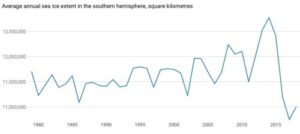by SCE-INFO, 3 juillet 2019 in ScienceClimatEnergie
De nombreux médias l’ont annoncé, tout comme le site MétéoFrance : la barre des 45 °C aurait été franchie pour la première fois en France vendredi 28 juin 2019. On a atteint 45,9 °C à Gallargues-le-Montueux, à l’ouest du Gard, à 16 h 20. Ce serait une première en France depuis que l’on fait des mesures de températures. Température exceptionnelle? Sans remettre en cause le réchauffement global de la basse troposphère, ni l’augmentation de la fréquence des vagues de chaleur constatée par le GIEC, certaines remarques doivent être faites concernant ce record de température.
Avant de sombrer dans le catastrophisme, il est important de “garder la tête froide” et de considérer les quelques points suivants :
1. Une telle température a peut-être déjà été atteinte dans le passé proche, mais n’a tout simplement pas été mesurée. N’oubliez pas qu’il n’y avait pas autant de thermomètres il y a cent ans. Par exemple, en 1865, il n’y avait en France que deux observatoires astronomiques effectuant des observations météorologiques quotidiennes (voir ici). Aujourd’hui, les stations météorologiques professionnelles du réseau de Météo-France, appelé réseau Radome, ne sont que de 554 pour le France métropolitaine. Il faudrait évidemment plus de stations pour monitorer les 643 801 km² de territoire. Aujourd’hui, cela fait une station pour 1162 km2.
2. Pendant l’été 1930, une vague de chaleur a traversé la France, comme l’atteste le petit article de journal ci-dessous (Figure 1) retrouvé dans “The Telegraph” (Brisbane). Les températures sont données en Fahrenheit et 122 Fahrenheit correspondent à 50°C. Bien que l’article ne donne pas les détails de la mesure (il faut donc rester prudent) nous voyons que de telles vagues de chaleurs se sont déjà produites dans le passé. Voyez également ce qui s’est passé en 1900, 1911, 1921 et 1934 ici.
…
by Allan M.R. MacRae, B.A.Sc., M.Eng, July 4, 2019 in WUWT
…
…
…
9. Conclusion
Radical green extremists have cost society trillions of dollars and many millions of lives. Banning DDT and radical green opposition to golden rice blinded and killed tens of millions of children.
Green energy and CO2 abatement schemes, driven by false fears of catastrophic global warming, have severely damaged the environment and have squandered trillions of dollars of scarce global resources that should have been allocated to serve the real, immediate needs of humanity. Properly allocated, these wasted funds might have ended malaria and world hunger.
The number of shattered lives caused by radical-green activism rivals the death tolls of the great killers of the 20th Century – Stalin, Hitler and Mao – radical greens advocate similar extreme-left totalitarian policies and are indifferent to their resulting environmental damage and human suffering… … and if unchecked, radical environmentalism will cost us our freedom.
by Robert W. Endlich, December 18, 2018 in CAtmSciForum
In describing the errors in the Fourth National Climate Assessment, ‘NCA4’, I’ll use the words from the Executive Summary which purport to link climate changes in the USA to global climate change.
The first claim, “The last few years have also seen record-breaking, climate-related weather extremes,“ is shown to be false, simply by examining climate records, some from the National Climate Data Center.
Tornadoes have been decreasing over the past six decades as temperatures moderate from the significant cooling of the 1940s to 1970s. As a basic knowledge of meteorology teaches, it is the pole to equator temperature difference that drives the intensity of cold season storms and especially the spring-season storms which bring the extremely strong tornado outbreaks.
…

Figure 1. Annual count of strong to violent tornadoes from 1954-2014, showing a significant decrease of tornado activity the past 60 years, based on data from NOAAs Storm Prediction Center. [Note: This graphic replaces the original graphic that showed all tornadoes EF1 and stronger. Correction made 1/25/2019].
…
by Adam Vaughan, July 3, 2019 in ClimateChangeDispatch
Decades of expanding sea ice in Antarctica have been wiped out by three years of sudden and dramatic declines, leaving scientist puzzled as to why the region has flipped so abruptly.
A new satellite analysis reveals that between 2014 and 2017 sea ice extent in the southern hemisphere suffered unprecedented annual decreases, leaving the area covered by sea ice at its lowest point in 40 years.
The declines were so big that they outstripped the losses in the fast-melting Arctic over the same period.
“It’s very surprising. We just haven’t seen decreases like that in either hemisphere,” says Claire Parkinson at NASA’s Goddard Space Flight Center, who undertook the analysis.
However, researchers cautioned against pinning the changes on climate change and said it was too early to say if the shrinking is the start of a long-term trend or a blip.
After growing for decades, Antarctic sea ice extent declined at an unprecedented rate between 2014 and 2017.

…
La géologie, une science plus que passionnante … et diverse


